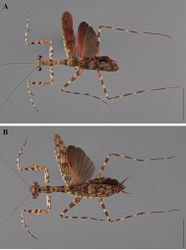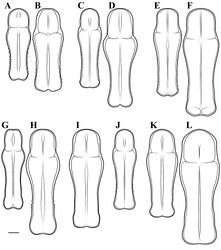Liturgusa krattorum
| Notice: | This page is derived from the original publication listed below, whose author(s) should always be credited. Further contributors may edit and improve the content of this page and, consequently, need to be credited as well (see page history). Any assessment of factual correctness requires a careful review of the original article as well as of subsequent contributions.
If you are uncertain whether your planned contribution is correct or not, we suggest that you use the associated discussion page instead of editing the page directly. This page should be cited as follows (rationale):
Citation formats to copy and paste
BibTeX: @article{Svenson2014ZooKeys390, RIS/ Endnote: TY - JOUR Wikipedia/ Citizendium: <ref name="Svenson2014ZooKeys390">{{Citation See also the citation download page at the journal. |
Ordo: Mantodea
Familia: Liturgusidae
Genus: Liturgusa
Name
Liturgusa krattorum Svenson, 2014 sp. n. – Wikispecies link – ZooBank link – Pensoft Profile
Type
Holotype Male, pinned. Cleveland Museum of Natural History, Cleveland, OH, USA.
Type locality
Peru: Loreto Province, Madre Selva Biological Research Station, -3.62096, -72.24744, 10-17 February 2013, Coll: G.J. Svenson, Tissue 005, GSMC004004. (Lat. -3.62096, Long. -72.24744).
Material examined
Liturgusa krattorum sp. n.
| Sex | Type | Country | Label | Latitude Longitude | Code |
|---|---|---|---|---|---|
| Male | Holotype | Peru | Loreto Province, Madre Selva Biological Research Station, -3.62096, -72.24744, 10–17 February 2013, Coll: G.J. Svenson - Tissue 005 | -3.620960, -72.247440 | GSMC004004 |
| Female | Allotype | Peru | Loreto Province, Puerto Almendra - Tissue 040 | -3.830525, -73.374000 | GSMC004032 |
| Female | Paratype | Peru | Rio Maranon, XII-30, F 6079, H. Bassler Collection | -4.832821, -76.639033 | AMNH 003 |
| Male | Paratype | Peru | Monson Valley, Tingo Maria, X-19-1954, E.I. Schlinger & E.S. Ross collectors | -9.314153, -76.006745 | CAS 008 |
| Female | Paratype | Peru | 20 mi. W. of Pucalipa, X-3-1954, E.I. Schlinger & E.S. Ross collectors | -8.354749, -74.552113 | CAS 019 |
| Male | Paratype | Peru | Loreto Province, Madre Selva Biological Research Station, -3.62096, -72.24744, 10-17 February 2013, Coll: G.J. Svenson - Tissue 026 | -3.620960, -72.247440 | GSMC004001 |
| Male | Paratype | Peru | Loreto Province, Puerto Almendra - Tissue 033 | -3.830525, -73.374000 | GSMC004018 |
| Male | Paratype | Peru | Loreto Province, Madre Selva Biological Research Station, -3.62096, -72.24744, 10-17 February 2013, Coll: G.J. Svenson - Tissue 002 | -3.620960, -72.247440 | GSMC004034 |
| Male | Paratype | Peru | Loreto Province, Madre Selva Biological Research Station, -3.62096, -72.24744, 10-17 February 2013, Coll: G.J. Svenson - Tissue 009 | -3.620960, -72.247440 | GSMC004035 |
| Male | Paratype | Peru | Dept. Loreto Rio Yubineto, 1-VII - 1.VIII - 1978, M. Descamps rec. | -0.999780, -74.253238 | MNHN 024 |
| Female | Paratype | Colombia | Dept. Amazonas, 30 KM. Aval de la Chorrera, Rio Igara - Parana, 1.2.II.1974, J. Desplats Rec. | -0.754819, -73.007213 | MNHN 082 |
| Female | Paratype | Peru | Dept. Loreto Rio Yubineto, 1-VII - 1.VIII - 1978, M. Descamps rec. | -0.999780, -74.253238 | MNHN 084 |
| Male | Paratype | Peru | Loreto, Pebas, River Amazonas, -3.329066°S, -71.854168°E, 28 Feb 2010, Coll: J.J. Ramirez | -3.329066, -71.854168 | MNHN 093 |
| Female | Paratype | Peru | Loreto, Iquitos, Nov. 2010, Collection Stiewe | -3.741872, -73.272190 | MSMC 002 |
| Male | Paratype | Ecuador | Pastaza; Ashuara, Rio Macuma, 10km from Rio Morona, 300m, VII:7-16:1971, le. B. Malkin | -2.753512, -77.444899 | FMNH 004 |
| Female | Paratype | Ecuador | Pastaza; Ashuara, Rio Macuma, 10km from Rio Morona, 300m, VII:7-16:1971, le. B. Malkin | -2.753512, -77.444899 | FMNH 011 |
Natural history
Males and female found in local abundance at the Madre Selva Biological Research Station in the Loreto Province, Peru. The species was living in sympatry with Liturgusa algorei on the same smooth bark, medium diameter trees. The species was easily collected during the day and often found at reachable heights in lower sections of the tree.
Diagnosis
Most similar to Liturgusa purus and Liturgusa algorei in body shape and slenderness, but far more green in coloration across head, pronotum, and prothoracic legs with highly contrasting banding across the body. In addition, the head is mostly pale, but the lower portion of the frons, the clypeus, mandibles and labrum are darkly colored. Forewings are browner than other two species with a pronounced green and dark banded costal region. Hindwings are darker than Liturgusa purus, but more rusty than Liturgusa algorei. In addition, the prothoracic femoral posterior genicular spine in females is elongate, but shorter than posteroventral spines, but relatively much longer than that seen in Liturgusa algorei.
Description
Male. (Fig. 26A) N=8: Body length 23.24–24.68 (23.94); forewing length 14.39–15.50 (14.91); hindwing length 11.33–12.48 (11.81); pronotum length 7.27–7.85 (7.62); prozone length 2.06–2.24 (2.13); pronotum width 2.21–2.41 (2.33); pronotum narrow width 1.51–1.71 (1.59); head width 4.70–4.92 (4.85); head vertex to clypeus 1.88–2.03 (1.96); frons width 1.64–1.77 (1.70); frons height 0.63–0.73 (0.67); prothoracic femur length 6.62–7.09 (6.90); mesothoracic femur length 9.40–10.17 (9.79); mesothoracic tibia length 7.46–8.28 (7.95); mesothoracic tarsus length 6.69–7.45 (7.06); metathoracic femur length 9.95–10.80 (10.28); metathoracic tibia length 9.93–10.86 (10.50); metathoracic tarsus length 10.12–11.52 (11.00); pronotal elongation measure 0.27–0.29 (0.28); pronotal shape measure 0.29–0.32 (0.30); head shape measure 0.40–0.42 (0.40); frons shape measure 0.36–0.42 (0.40); anteroventral femoral spine count 15–17 (16); anteroventral tibial spine count 10–11 (10); posteroventral tibial spine count 7. Head (Fig. 44G): Transverse, juxta-ocular protuberances medium, the apex in the lateral third; the vertex between the parietal sutures is straight; vertex even with the dorsal margin of the eyes. Frontal suture with a medial carina forming a continuous arc. Ocelli small and protruding on a small cuticular mound, but almost flat. Lateral ocelli oriented outward, a few degrees off perpendicular. Upper margin of clypeus barely convex, lower margin straight. Antennae pale basally fading quickly to black. Broad black band extending straight over the medial carina of the frontal suture; lower region of frons with two black marks separated by a pale gap centrally; the clypeus brown on lateral and lower region; the mandibles and labrum dark brown; the vertex and juxta-ocular protuberances splotched with brown and green; the area adjacent to lateral ocelli black. Palpi are pale.
Pronotum (Fig. 49G): Elongate with a moderately defined supra-coxal bulge; dorsal surface entirely smooth. Prozone with lateral margins that are near parallel, tapering anteriorly; the margins smooth. Metazone with concave lateral margins, a slight bulge in the posterior half; margins with numerous small tubercles; posterior margin medially emarginate; the dorsal surface of the posterior half moderately depressed. Green coloration dominant, but a few strong black marks.
Prothoracic Legs: Femur elongate with a slightly concave dorsal margin; strongly defined pale to dark banding on posterior (external) surface; anterior (internal) surface with a black band running medially from the base to terminus; the ventral surface pale. Posterior surface of femur with few tubercles. A well developed femoral pit to accommodate terminal posteroventral tibial spine positioned medially to the proximal two posteroventral spines and in line with the distal most discoidal spine; pit is pale. Posterior prothoracic femoral genicular spine at most a quarter the length of the posteroventral spines, originating just distal to the beginning of the genicular lobe. Prothoracic tibial posteroventral spines with the first (proximal) smallest and the second through sixth of similar length, the second and third are slightly longer than adjacent spines. Prothoracic coxae smooth; the anterior surface with a broad, black band medially in the proximal half as well as a black spot medially towards the distal terminus.
Meso- and Metathoracic Legs: Femora with ventral (posterior) carina; dorsal (anterior) carina faint. Mesotarsi with first segment approximately equal to remaining segments combined.
Wings: Forewings mottled with brown, green, and pale coloration; the costal region with green and dark irregular banding. Forewings colored asymmetrically, one being mottled the other is rust colored with the mottled pattern still visible. Hindwings with a red or rusty color in the discoidal region, darkening distally to black; the anal region rusty basally and fading to a smoky grey and translucent medially before becoming black along the distal margin; the terminus of the discoidal region projecting well beyond the distal margin of anal region, the wings appearing elongate.
Abdomen: Elongate, tubular with slight widening before posterior narrowing; smooth, black and green colored dorsal surface. Supra-anal plate transverse, tapering to a broadly rounded terminus. Subgenital plate irregularly rounded and without styli.
Genital Complex (Fig. 52I.1): The main body of ventral left sclerite (L4A) with a dull or sharply pointed, sickle shaped distal process (pda) positioned laterally, the terminal margin of the L4A centrally rounded before a depression that leads to the pda. The apofisis falloid (afa) of the main body of dorsal left sclerite (L4B) straight, tapering into a needle-like process; the apical process (paa) broad, cylindrical and curved, the terminus a blunt and rounded end. The right dorsal phallomere (fda) of the first sclerite of right phallomere (R1) tapers to a rounded terminus, both margins sclerotized with a broad central membranous gap; the ventral plate (pia) strongly sclerotized and broad, with strong and numerous, curved grooves; the ventral process (pva) c-shaped, tapering to a point distally.
Female. (Fig. 26B) N=6: Body length 30.58–37.69 (33.14); forewing length 17.74–19.93 (18.91); hindwing length 15.02–15.97 (15.35); pronotum length 9.32–10.93 (9.86); prozone length 2.66–3.00 (2.78); pronotum width 2.94–3.40 (3.10); pronotum narrow width 2.08–2.24 (2.15); head width 5.90– 6.84 (6.22); head vertex to clypeus 2.57–2.91 (2.72); frons width 2.32–2.61 (2.42); frons height 0.86–0.97 (0.92); prothoracic femur length 8.37–9.90 (8.94); mesothoracic femur length 11.25–12.67 (11.80); mesothoracic tibia length 9.08–10.45 (9.65); mesothoracic tarsus length 7.59–8.47 (7.95); metathoracic femur length 11.44–13.44 (12.20); metathoracic tibia length 11.53–14.03 (12.91); metathoracic tarsus length 11.71–14.80 (13.13); pronotal elongation measure 0.28–0.29 (0.28); pronotal shape measure 0.30–0.33 (0.32); head shape measure 0.42–0.45 (0.44); frons shape measure 0.35–0.40 (0.38); anteroventral femoral spine count 14–16 (16); anteroventral tibial spine count 10; posteroventral tibial spine count 7.
Head (Fig. 44H): Juxta-ocular protuberances large, the apex in the medial third; vertex well above the dorsal margin of the eyes. Upper margin of clypeus barely convex, lower margin straight with medial bulge.
Pronotum (Fig. 49H): Prozone with lateral margins that are parallel, tapering anteriorly; the margins smooth. Metazone with concave lateral margins, a barely visible bulge in the posterior half; margins with small tubercles medially. Highly contrasting green and black coloration.
Prothoracic Legs: Femoral pit is black. Posterior prothoracic femoral genicular spine smaller than posteroventral spines, originating distal to the beginning of the genicular lobe. Prothoracic tibial posteroventral spines with the first (proximal) smallest and the fourth through sixth of similar length, the second and third are much longer.
Meso- and Metathoracic Legs: Femora with ventral (posterior) carina; dorsal (anterior) carina obvious.
Wings: Forewings colored symmetrically or asymmetrically, one being rust colored. The anal region of hindwings rusty basally and fading to a smoky grey and translucent medially before becoming black along the distal margin; the terminus of the discoidal region projecting beyond the distal margin of anal region.
Abdomen: Widening from first segment until the beginning of the distal half (segments 5–6) when the lateral margins narrow to the terminus, the middle being the broadest region. Tergites without posterolateral tergal projections. Supra-anal plate as long as wide, evenly rounded.
Etymology
A noun in the genitive case, Liturgusa krattorum is named for Chris and Martin Kratt, hosts and creators of Kratts’ Creatures and Wild Kratts, among other television shows, which provide children with entertaining programming focused on animal biology presented with accurate information.
Original Description
- Svenson, G; 2014: Revision of the Neotropical bark mantis genus Liturgusa Saussure, 1869 (Insecta, Mantodea, Liturgusini) ZooKeys, 390: 1-214. doi
Images
|



